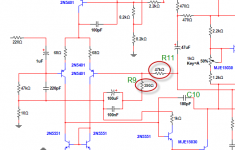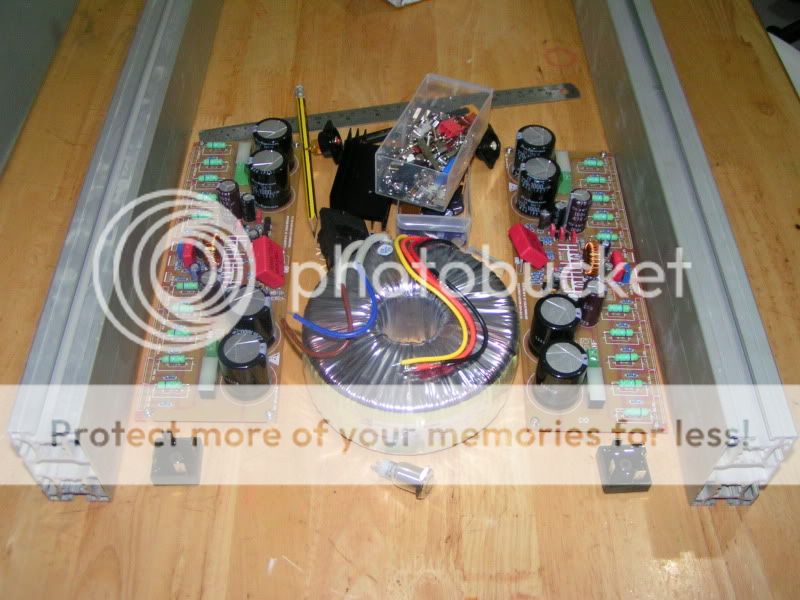it is built to meet domestic style listening duty at home.
That is quite different from Public Address (PA) duty to a large audience, who may have paid to hear.
That is quite different from Public Address (PA) duty to a large audience, who may have paid to hear.
it is built to meet domestic style listening duty at home.
That is quite different from Public Address (PA) duty to a large audience, who may have paid to hear.
you are trying to tell that it will not work for longer continuous working as it wont work for rugged usage as in pa right?
domestic duty is completely different from PA duty.
It will play forever (I exaggerate slightly) on domestic duty with appropriate speaker load.
It will play forever (I exaggerate slightly) on domestic duty with appropriate speaker load.
Member
Joined 2009
Paid Member
stability depends a fair bit on the load the amp is driving, with shortish speaker cables and no exotic (strange reactance) speakers the amp will likely be just fine. But you may find it interesting to change Cdom and listen to the amp - too high and it's tizzy sounding, too low and the sound is dull, just right (the goldilocks value) and the amp will sound great.
stability depends a fair bit on the load the amp is driving, with shortish speaker cables and no exotic (strange reactance) speakers the amp will likely be just fine. But you may find it interesting to change Cdom and listen to the amp - too high and it's tizzy sounding, too low and the sound is dull, just right (the goldilocks value) and the amp will sound great.
So for PA use the amplifier may not be stable
So for PA use the amplifier may not be stable
emmi, Bigun is not talking about PA, but rather a technical question before your posts...
So nobody played with Cdom yet?
I'm still waiting on a few parts to complete my board then I'll get on it assuming there are no hitches. Curious what measurements others might be interested in. I can do basic 1 Khz THD and also look at square wave response to get an idea of slew rate. Of course will be looking for any signs of oscillation. I'm also considering reducing the value of the input bias resistor and the larger of the feedback resistors as an alternative way to reduce the gain rather than increasing the smaller FB resistor. Comments?
Hello,
Is there anyone documenting what is being done regarding adjusting amplifier gain and feedback. A detail entry would be helpful ..
regards,
Is there anyone documenting what is being done regarding adjusting amplifier gain and feedback. A detail entry would be helpful ..
regards,
Hello,
Is there anyone documenting what is being done regarding adjusting amplifier gain and feedback. A detail entry would be helpful ..
regards,
It's rather simple...
Carlos arranged to eliminate the need to use a preamp and to connect portable players directly to his amps. These devices have a rather low output power to feed an amp, so a pre-amp is normally used to boost their signal before definitive amplification.
To have full output power using these devices without a preamp, the sensitivity of the input, or the gain of the amplifier needs to be multiplied by 3x or 4x. so instead of having a gain of around 30x, the amp have a gain of 122x
The gain factor is determined by resistors R11 and R9. The calculation is: (R11+R9)/R11, or R11/R9 + 1
To have the gain in dB, the formula is: 20 x LOG(gain factor)
To have gain factor from gain in dB, the formula is: 10 at power(gain in dB/20)
The gain is reduced by increasing the negative feedback at the differential pairs. This is achieved by increasing the resistance between the feedback rail to the ground (R9)
If you look at the initial schematics, R11 is 47K and R9 is 390r. This indicates a gain of 121.5x, or 41.7dB.
However by looking all the consumer power amplifiers in that power range, the gain is normally around 29dB, or 28.2x.
Some of us that uses a preamp got wayyyy too much gain using the values established by Carlos, so it has been expressed that increasing R9 value would resolve that.
Each one that played with it probably came to different conclusion but some things remains:
- When decreasing the gain, the input sensitivity is decreased as well so external interferences are less amplified which leads to less hiss or hum;
- When increasing the feedback (to reduce gain) it has the effect of reducing the THD of the unit;
- When increasing the feedback, it has the effect of making the unit more prone to instability and oscillations. The stability relies in great part on the miller capacitor (C10). Its value shall be reviewed when global feedback is altered. The discussion is around that capacitor these times.
My personal adjustments goes this way: R9 has been increased to 1.5K which gives a gain factor of 32.3 (30.2dB gain). I didn't touch C10, it's still at 180pF.
I'm pleased by the fact that it's now dead silent while idling (no hiss or hum perceivable).
The sound has change a very little bit in the high-mids that seems less crude, more soft and gentle.
Although I have no instruments to check for oscillations, it's cold running temperature tends to indicates that it does not oscillate.
Martin.
Attachments
A month ago I altered almost same what you did Martin except that my R9 changed to 2.2k, and input cap to a series of 10uF caps which give me 5uf in total. Still the best sounding amp i have at home.
Yes,
changing the gain changes the stability margins.
Carlos' crude methodology is not applicable.
He never "designed" the amplifier in the "normal" manner and thus his gain adjustment falls into the same never "designed" category.
Another confirmation. Changing the gain will not only change the multiplication as the signal passes through the amplifier, it also changes the shape of the signal. That change of shape is heard as a change in the sound.
changing the gain changes the stability margins.
Carlos' crude methodology is not applicable.
He never "designed" the amplifier in the "normal" manner and thus his gain adjustment falls into the same never "designed" category.
Another confirmation. Changing the gain will not only change the multiplication as the signal passes through the amplifier, it also changes the shape of the signal. That change of shape is heard as a change in the sound.
A month ago I altered almost same what you did Martin except that my R9 changed to 2.2k, and input cap to a series of 10uF caps which give me 5uf in total. Still the best sounding amp i have at home.
Junie, about the input cap, how did the sound changed? Did you alter any input resistor as well?
Thanks,
Martin.
Only the input cap, input resistor same value...improvement in vocals is what i've noticed it's sounds more realistic this time unlike before it's sounds like inside the "DRUM". I don't have an equipments to do measurements but my ears can hear the changes 🙂.
Why not take out the Input cap completely .. ....
Wayne I'm using a passive attenuator.
- Status
- Not open for further replies.
- Home
- Amplifiers
- Solid State
- Dx Blame MKIII-Hx - Builder's thread

